Last week Houston enjoyed a healthy dose of real Winter weather (finally!), on Wednesday I was manning a booth for Dress For Success Houston at my neighborhood Whole Foods, the location was appropriate for food thoughts. There I was trying to figure out what to make for dinner, I knew that The Hubbz would enjoy something warm and comforting as much as I would, so a soup of some sort seemed in order. Something creamy, rich, with fish and Panamanian flavor, that’s what I wanted. CHOWDER!

I quickly started jotting things down, instead of clams, fish. No potatoes, let’s use chayote instead. Skip the cream and go for some coconut milk and some salty, fatty pork was mandatory. So I ended up with El Fish Chowder-o. It was delicious, I used some leftover rice to thicken it up a bit and should’ve ran it through the blender, but I got lazy and hungry. Aside: Hubbz, if I had a handy immersion blender I would’ve never skipped this step…, hint, hint. No matter. I took a whisk and made sure all the rice grains were completely obliterated and it was pretty velvety.
You may be wondering what any of this has to do with Iron Chef Morimoto. Well, let me tell you. I know you will have some doubts about this part of the story, but I’ve never lied to you and never will. On day 2 of El Chowder-o, The Hubbz and I were watching Iron Chef Morimoto battle Chef Mehta, the mystery ingredient: Coconut. Morimoto proceeds to work his magic with coconut in every conceivable variation and then it happened. He started making a clam chowder. He cooked a bit of rice in coconut milk and used it as a thickener for the chowder and added more coconut milk to make the broth. Of course my dish styling wasn’t as gorgeous as his, but I had a Morimoto genius moment!

El Fish Chowder-O
1 lb fish (I used some striped bass and salmon), cubed
Salt pork or bacon, diced
2 garlic cloves, crushed
3 culantro leaves or 3 cilantro sprigs
about 6 cps broth
1/2 cp rice, cooked
1 can coconut milk
2 chayotes, peeled & cubed
3 green onions, diced
Salt & black pepper

In medium pot, render the fat from the bacon, add the garlic and cook until soften, add the coconut milk, broth and rice, season with salt and pepper, simmer for about 30 minutes until rice disintegrates. At this point you can run it through the blender to get a smooth broth.
Return to the pot and add the chayote, allowing to cook until fork tender. Once the chayote is cooked, add the fish and 1/2 of the green onions. Simmer for about 10-15 minutes until the fish is cooked and flaky. Add the rest of the green onions and serve with crusty French bread.
Cookingly yours,
Anamaris

At the corner or Richmond and Mid Lane sits an unassuming establishment called Nielsens Deli. I had driven by this place countless times since moving to Houston, but never thought about stopping by, I imagined it was just a deli selling deli meats. Recently, a good friend invited me out for a quick lunch promising me I would have the best potato salad and deviled eggs EVAH! Off to Nielsens we went.
As you walk into the stand-alone building, you’ll come into a long narrow room, the deli counter will be just a couple of feet and directly across from the front door, that’s where you place your order, unless you’ve called it in. Turn right and to the opposite end of the room, pick up some chips and pay for your order. If you’re dining in, you can grab one of the stools lined up against the storefront glass. If you’re feeling particularly playful, tease the incoming customers as they come up to the counter.

Ok, this is a food blog, right? Let’s talk shop. First, I was tickled by the lingo I heard as I approached the counter. The customers, regulars no doubt, have learned how to properly order their meals: ‘a Jr Corned beef, extra spread on rye and a pixie potato salad‘. It made me think of a kinder, gentler soup Nazi.
I’m not a big sandwich person, it just doesn’t seem like a meal, but these sandwiches are awesome! I had the corned beef on white with extra spread (they make their own mayo…OHMY!), an egg and a pixie of egg salad. Let me tell you, this corned beef was good and piled high on the homemade bread. No skimping here.
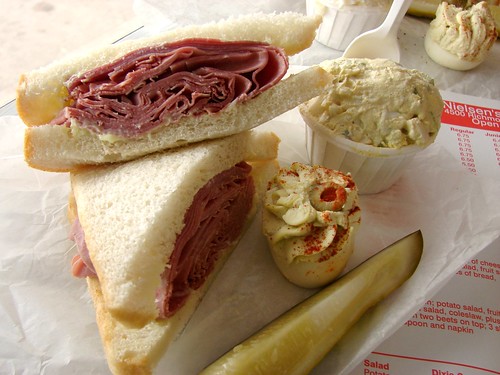
Anni had the turkey on white, extra spread an egg and a pixie of potato salad. I had a bite of her turkey and was surprised by how flavorful it was. They’ve been roasting their own turkey breasts since the deli opened in 1952, I think they have it down.

Now. For the really exciting part. Those sides. I love potato salad, but not the mustardy kind and not with a bunch of stuff in it. KISS (keep it simple, sweetie) is my motto. And KISS it they do. Loads of their amazing homemade mayo, piled with eggs and celery for some crunch, this potato salad ROCKS! It is so good that years ago Gourmet magazine sent a letter requesting their recipe!
Then we go into the deviled egg territory. Insanity, that is all I can say about it. Next time I go, I will have the chicken salad sandwich, apparently it is incredible. And I believe it, because I had a pixie of the egg salad… it was as if they just chopped the deviled eggs and stirred it all up.
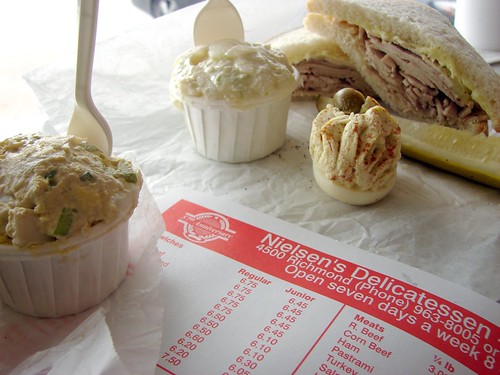
If you’re from Houston, you should definitely visit this Houston institution, do it soon! It’s just inside the loop at Richmond. If you’re coming to Houston for a visit, put this one on the list.
Nielsen’s Deli (daily from 8:00 a.m. to 4:00 p.m)
4500 Richmond Avenue
713.963.8005
Eating around,
Anamaris
Here it is, another Wednesday, another shot. If you’re following my photo challenge, you’ll remember that all the shots for Shutterboo’s challenge are here.
This week was all about color. Here’s a tease, but to see the shot I submitted, you’ll have to go here or here.

See ya next time!
Anamaris
 This week Foodalogue’s Culinary Tour will take us to the Republic of Turkey. Do you have your passport? It’s ok, you don’t really need it, I can get you through. We’re going to Turkey this week. Not the bird, the country. Turkey calls Bulgaria, Greece and Syria neighbors–among others. Turkey is a relatively young country, established in 1923 after the defeat of the Ottoman empire. I’ve never been, but I hear it is simply breathtaking and exciting.
This week Foodalogue’s Culinary Tour will take us to the Republic of Turkey. Do you have your passport? It’s ok, you don’t really need it, I can get you through. We’re going to Turkey this week. Not the bird, the country. Turkey calls Bulgaria, Greece and Syria neighbors–among others. Turkey is a relatively young country, established in 1923 after the defeat of the Ottoman empire. I’ve never been, but I hear it is simply breathtaking and exciting.
I can’t say I am intimately familiar with Turkish cuisine, but Google is my friend and I know more about it today than I did yesterday. Since Turkey was ruled by the Ottomans for a while, you will notice their cuisine harmonizes with that of Central Asia, the Middle East and the Balkans. As with most countries, the cuisine will vary from region to region, but there are still some common ingredients, such as eggplant, green peppers, lentils, pistachios and a number of herbs.
There is also an emphasis on desserts. Turns out, baklava is a Turkish specialty! Yes, I know. I always thought this was a Greek specialty, just as I thought it was always made with honey. How did I ever survive without the Internet, I will never know. What I do know is that baklava has strong ties to Turkey, that there are other desserts similar to it and they don’t have to include honey!!! A definite win in my book.
Wikipedia provided a very detailed compilation of Turkish desserts. The list started off with baklava and then mentioned other similar treats. Enter Sobiyet. I’m going to say that Sobiyet is the baklava’s uppity cousin. Or the fat one. Just like baklava, Sobiyet starts off with layers upon layers of buttery pastry, but it is then crowned with a creamy filling. I found an excellent recipe here.
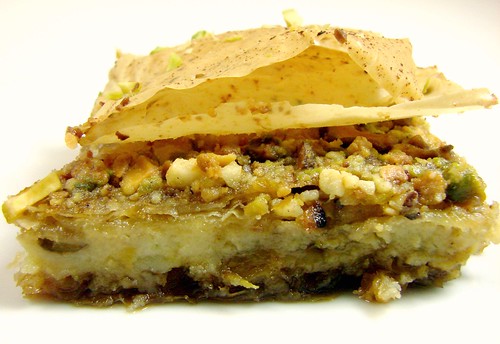
Following Joan’s Culinary Tour, I have a choice as to how I honor the destination. I can:
- go traditional: make one of the country’s national or traditional dishes.
- choose a contemporary approach: take a traditional recipe and contemporize it.
- or go for a wild card and use the flavors and techniques of the country we are visiting, and create my own recipe.
This time I opted for a contemporary approach and tweaked the traditional Turkish recipe by substituting with my Latin stuff. Actually, I Panamanianized it, as the substitutions are very common ingredients in Panama. I added cashews, instead of using regular sugar or honey, I went for raspadura–unrefined sugar cane and I also added orange peel, cinnamon sticks and cloves for aromatics.
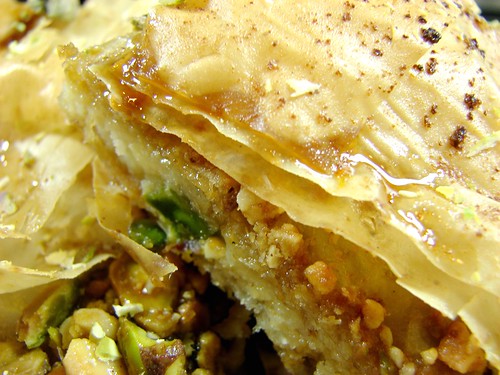
Cashew & Pistachio Sobiyet
I came across a delicious recipe by Mercedes over at Dessert Candy and followed it pretty closely except for the following changes:
For the custard filling: I allowed the milk to steep with a few cloves and a cinnamon stick, which I strained before adding the semolina. Once the custard had thickened, I added a bit of nutmeg and pureed raw cashews.
For the syrup: I replaced the sugar with raspadura, added the zest and of an orange, and a bit of vanilla extract.
For the assembly: I sprinkled chopped cashews and pistachios over the custard. Also, when I had 2 or 3 sheets left, I topped the layer with more pistachios, I wanted the color to show through the top. I finished with more buttery phyllo.

I kinda free-formed it into a round; once all the layers were in place, I used the last 2 layers to tuck all the edges under.
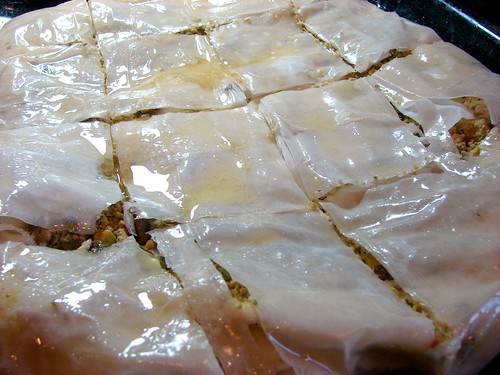
The result was a crisp, moist, sticky pastry that was (still is, there are a few pieces left) just sweet enough. The raspadura gave it a taste of caramel that seems to be perfumed with anise. It makes me think of toffee. Well, there are a lot more shots, if you care to look here.
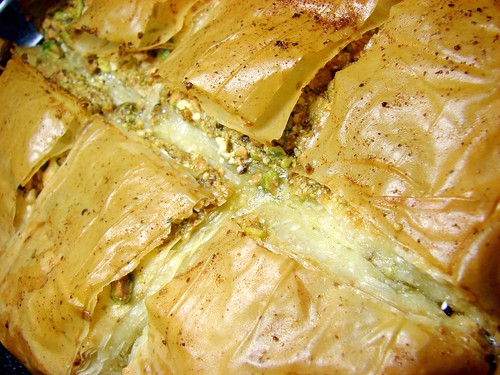
This was an exciting destination, be sure to stop by and visit with my fellow travelers. Joan made a sinful looking dish with eggplant and my dear Norma made a 2-layer rice pudding. Join us at the next destination, Japan.
Cookingly yours,
Anamaris
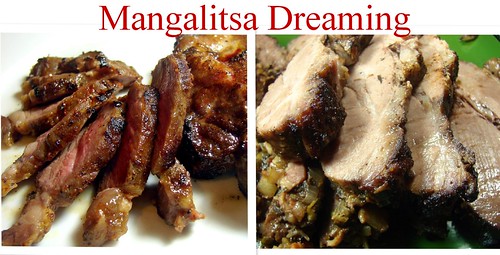
Just before Xmas one of my recipes was chosen by the folks at Marx Foods as their favorite use of cured Mangalitsa ham. To my surprise, they sent me more Mangalitsa goodness! Only, this time, it was a fresh, not cured, piece of meat. A neck roll, to be precise. This was a gift from Marx Foods and Heath Putnam Farms (they raise the piggies).

After some research, I learned that this cut is known as Secreto (secret) in Spain because it is the butchers’ best kept secret and I can understand why they keep this cut to themselves. Per Heath, this cut is known as pork collar or coppa and it is all the rage at the fancy eateries these days. He suggested preparing the roll in a couple different ways. First, I should slice a few pieces and sear them in a pan, then roast the rest. I listened and took his advice to heart; boy am I glad I did.
Since it arrived just around the holidays, my intention was to prepare and share with you another dish rooted in my Panamanian heritage , but, alas! I was so busy towards the end of the year, I never got around to posting it, though I did cook and eat it. Oh yes we did! I kept thinking about lomo relleno (stuffed loin), which is a dish typically served around the holidays. It can be beef or pork loin and it is generally stuffed with carrots, olives, raisins and many variations after that. Let’s talk pig!
Stuffed Mangalitsa Pork Collar
I wanted to make sure the meat itself was seasoned, so I made a nice rub for it. I combined Spanish paprika, pureed garlic, sea salt and black pepper with a bit of extra virgin olive oil and rubbed onto the pork collar, allowing it to marinate for a few hours.
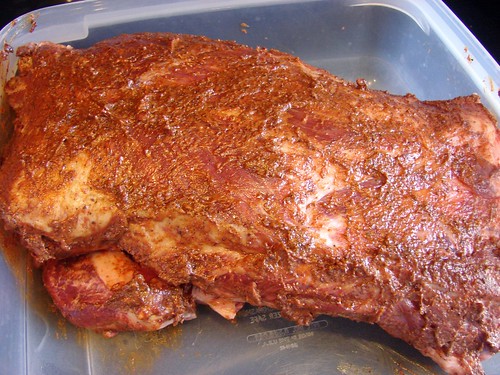
For the stuffing I chopped and rendered the fat out of some bacon, then cooked in some chopped onions, garlic, cilantro and prunes. I did allow this to cool completely before stuffing the pork. I didn’t go fancy butterflying route, instead, I simply sliced the pork collar, just shy of about an inch from the opposite end and piled it with the stuffing*.

A little twine helped keep everything even and in place for searing and roasting. You can opt-out of pan searing and simply cook it at 450° for the first 15 minutes, then lowering the temperature to 300° for the remainder of the roasting time.
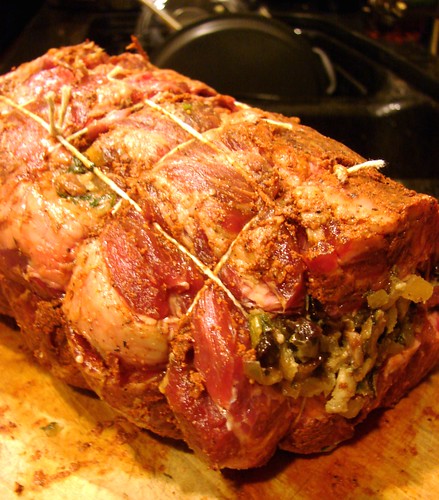
I placed it on a roasting rack with some carrots, onions and garlic strewn about the bottom of the pan. This was a 4-lb piece of meat an it roasted for about 3 hours or so, until the thermometer read 145°. I then removed it from the oven and allowed it to rest for about 15 minutes covered with foil. Believe me, we had a REALLY tough time staying away from it that long.
*Following Heath’s suggestion, and to keep us at bay while this baby roasted, I sliced off a few pieces of the collar before I made the cut for the stuffing. I heated a saute pan and added just a dab of olive oil and seared those little collar cutlets, they were about 1/2-inch thick and cooked for 2 minutes or so on each side, we still wanted them to be pink. That’s how we like our piggy. And…Oh.eM.Gee!!! We thought we’d died and gone to heaven.

Let me just try to explain something about Mangalitsa pork. It is obnoxiously delicious! I mean, I just know those little pigs trot around the pen mocking the other pigs and telling them how much better tasting they are. And you know what? THEY ARE!!! The Hubbz said this was better than beef tenderloin, yep. THAT good. The fat in the Mangalitsa is almost creamy buttery. And the meat has a slight gamey sweetness to it. I don’t know what to say or think about it, all I know is this is some really good sh#t!
Back to the roast. Once it rested and all the juices had redistributed around, we snipped off the twine and began slicing the roast.

Undoubtedly, the prunes added a delicious sweetness to the meat, just a hint, don’t worry. We feasted on this roast for a couple of days. By the time we were down to just a few bits and ends, I pan fried them to get a bit of a crust on the meat and used it to topped toasts points that had been toasted with olive oil and gotten a light spread of a fig & olive tapennade. JOOOOOOOOOYYYYY!!!! Sorry, no pictures of that madness.
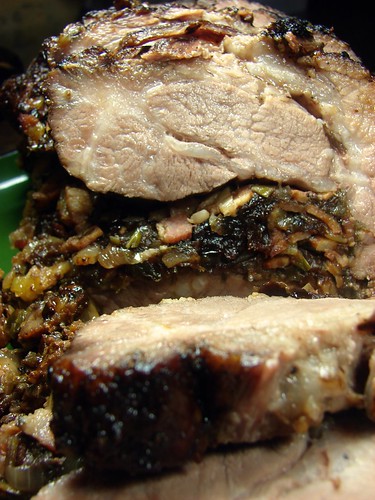
I will admit that we are completely in love with Mangalitsa and with the Secreto cut. I also have to admit this will be one of those things we purchase once a year for VERY special occasions, but purchase it we will! I’d like to thank Marx Foods and Heath Putnam Farms again for such a generous and DELICIOUS treat. You can see all the porky shots here.
Mangalitsa longingly yours,
Anamaris
There’s a picture challenge shot!!! This isn’t really a post, just a teaser. Go see my shots AND don’t forget to see all the shots from all the participants here. You should really join us, really.
This week it was all about CONTROL, you know, the kind that makes you go check out the shots. Go.

This is one of two dishes I prepared to participate in Foodalogue’s Culinary Tour, this time visiting my stomping grounds, Panama! This dish came to be as a result of a ‘What’s in the Bag‘ challenge posed by my dear Hubbz. He went to the store and brought everything but the butcher’s block, which I then had to incorporate into a Latin meal.
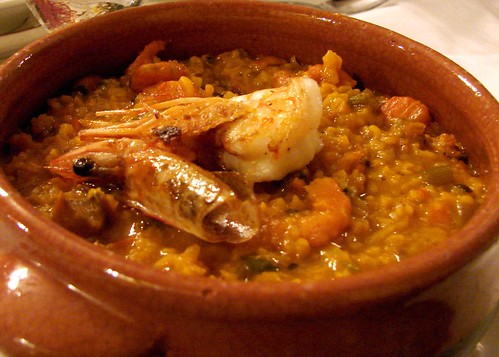
Seafood Guacho at Las Tinajas in Panama
Guacho (pronounced Wah-cho) is a popular Panamanian specialty; a slightly soupy rice dish, similar to an Italian risotto or a Puerto rican asopao. Unlike risotto, guacho is made from regular, long grain white rice that is soaked in water for a bit before it is sautéed and simmered in the cooking liquid of choice. The dish is then flavored and augmented with an array of local ingredients; there’s always some sort of meat or protein from pork, chicken, cured pig’s tails, or seafood, in addition to various beans and roots such as yuca and otoe.
Different from the way I’ve usually explained how to cook rice, the rice in guacho wants for more liquid and a longer cooking time, this allows for the rice starches to develop into a creamy, rich frenzy. I pretty much stuck to the traditional elements of the dish, only straying away in the preparation of the sofrito and by adding mushrooms to the rice itself.
Panamanian sofrito is generally made with onions, bell peppers, tomatoes, garlic and a few other aromatics, this time I included dried chile ancho and guajillos. But enough chatter, let’s cook!

Guacho de Mariscos y Hongos (Seafood & Mushroom Guacho)
6-8 servings
For the guacho:
2 cps long grain rice, soaked
Water
1/2 cp bacon, chopped
Extra virgin olive oil
1 cp mushrooms, diced
1/2 cp shallots, diced
About 8 cps seafood broth
1 cp shrimp, peeled & deveined
1 cp scallops
Sea salt
5 tbsps chile puree
2 cps sofrito
For the sofrito:
2 tbsp extra virgin olive oil
1 cp yellow onions, finely chopped
1 clove garlic, crushed
3 green onion sprigs, finely chopped
3 ripe tomatoes, finely diced
6 tbsps chile puree
Sea salt and a pinch of sugar
In a medium pan heat the oil and add the onions, cook them until soften before adding the garlic and green onions. Then add the tomatoes, 1/2 cp water and chile puree, lower the temperature and allow it to simmer for about 20 minutes. Keep warm.

For the seafood broth: I used the skins from the shrimp, bringing them to a simmer with plenty of water, 1 clove garlic, one of the dry ancho chilies, cilantro (culantro, if you can find it), 1 carrot, salt & pepper. Strain and set aside.
For the chile puree: Rinse and seed the chilies–remember Panamanian food is not typically spicy hot. Put 2 ancho and 1 guajillo chilies in a small pot with 2 cps water, 1 clove garlic, a pinch of salt and simmer for about 10 minutes until the chilies soften. Allow it to cool before running it through the blender. Set aside.
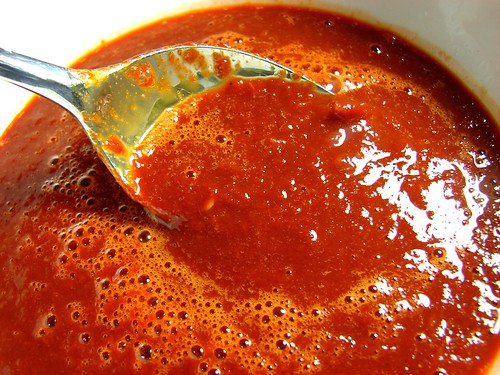
For plating: Reserve a few shrimp and scallops to place over the finished dish.
Preparation – Guacho:
Rinse the rice, then add enough cool water to cover it and allow it to soak for at least 20 minutes and up to 1 hour. In a large pan, render the fat from the bacon, but don’t crisp it. Add the onions and allow to cook until they begin to soften. Then add the mushrooms and cook for about 3 minutes.
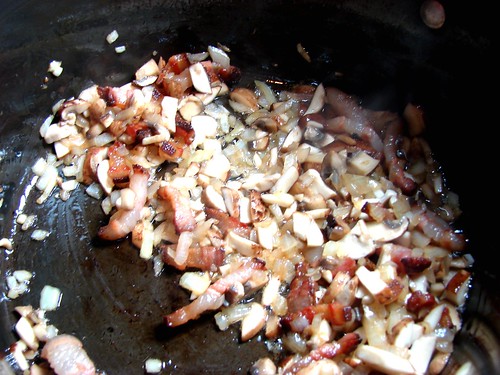
Drain the rice and add to the pan. If necessary, add a bit more olive oil, just enough to coat all the grains. Add 2 tbsps of the chile puree, 6 cps of the seafood broth and adjust the seasoning by adding sea salt as necessary. Lower the temperature to medium-low and allow it to simmer until the broth evaporates. Stir it every so often to make sure nothing gets stuck to the bottom of the pan.

While the rice is cooking, prepare the seafood: chop the shrimp and scallops to bite sizes (remember to save a few of each for plating). Marinate all the seafood (including those for plating) with 2 tbsps of the chile puree and a bit of sea salt and black pepper; set aside until needed.
Once the broth has evaporated, check the doneness of the rice grains. They should be fully open and swollen. If the liquid has evaporated completely, add a bit more broth or water, then add the chopped seafood. Stir in the seafood, bring the temperature to low and allowing to cook covered for another 5 minutes.

In the meantime, saute the reserved shrimp in a bit of olive oil, set aside. When ready to serve, spoon some guacho on the bottom of a bowl, top generously with a couple tbsps of sofrito and top with the sautéed seafood. Enjoy and Buen Provecho!

For the rest of the yummy guacho shots, follow this link. You can also see  the other dish, Langostinos en Caramelo de Maracuyá (Prawns in Passion Fruit Caramel) by following this link. And don’t miss the entries submitted by other food bloggers, visit Foodalogue for the tasty bits.
the other dish, Langostinos en Caramelo de Maracuyá (Prawns in Passion Fruit Caramel) by following this link. And don’t miss the entries submitted by other food bloggers, visit Foodalogue for the tasty bits.
Cookingly yours,
Anamaris
 I made this awesome dish as my contribution to Foodalogue’s Culinary Tour as she takes us and her readers to my homeland, Panama! The criteria to participate in the tour is pretty relaxed, you can either prepare a traditional dish in a) a traditional way, b) traditional dish modernized or c) just implement local ingredients and/or techniques. This particular recipe is one of 2 I shared and it showcases local ingredients in a modern or contemporary way, the other was an almost traditional Seafood Guacho.
I made this awesome dish as my contribution to Foodalogue’s Culinary Tour as she takes us and her readers to my homeland, Panama! The criteria to participate in the tour is pretty relaxed, you can either prepare a traditional dish in a) a traditional way, b) traditional dish modernized or c) just implement local ingredients and/or techniques. This particular recipe is one of 2 I shared and it showcases local ingredients in a modern or contemporary way, the other was an almost traditional Seafood Guacho.
The recipe comes from a beautiful cookbook I picked up on my last trip to Panama. ‘Sabores de Panamá‘ (Flavors of Panama) by Jorge Jurado, one of Panama’s renown chefs who has tasked himself with bringing traditional Panamanian dishes to the next level. The recipe showcases popular local ingredients: shrimp, passion fruit, chayote squash, coconut and sugar cane, these are then elevated when combined with fish sauce and smoked paprika and a beautiful presentation.
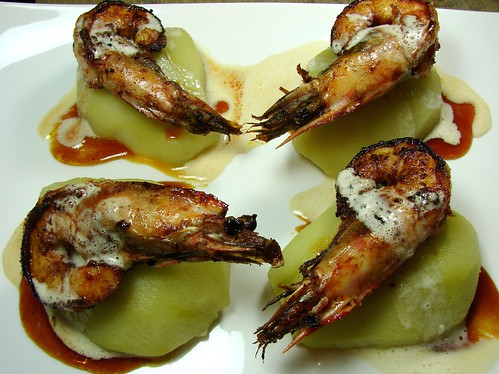
Let’s talk about the ingredients, shall we? Panama is all about the seafood, man. So much so that it is sold door-to-door. Yep, you read right. A few years ago, my dear friend Dorothy went to Panama with me and we stayed at my parents’ home. One morning while we were starting to wake up, we heard a man’s voice over a loudspeaker saying ‘Pescao, pescao, pargo, corvina, cojinoa, PESCAO’. A wave of giggles ensued, she looked at me awestruck. I had mentioned this phenomena to her, but I think she secretly doubted my honesty. See, about 3 times a week, there’s a guy in a truck who drives around my parents’ hood selling the morning catches, it doesn’t get any fresher than that. We didn’t have the ice cream truck, we get the seafood truck.
OK, back to the components of this magical dish. Chayote is a variety of squash that is as readily available in Panamá as zucchini and yellow squash is in the US. Like zucchini, it is very light, has a great deal of water content and a very mild taste with a discernible sweetness. A tart and luscious caramel made of raspadura, unrefined sugar cane, and passion fruit works beautifully with the mild flavors of the chayote and the spiciness of the smoked paprika and habanero pepper and the creamy coconut sauce. I fell in love with this dish, I think you will too.
Langostinos con Caramelo de Maracuya, Chayote y Aire de Coco (Prawns with Passion Fruit Caramel, Chayote and Coconut Foam)

For the prawns:
20 head-on large prawns, peeled & deveined
1 tbsp Spanish paprika
1 tbsp brown sugar
1 garlic clove, crushed
Sea salt & black pepper
Mix the ingredients together and use to marinate the prawns. Allow them to marinate while you prepare the rest of the components.
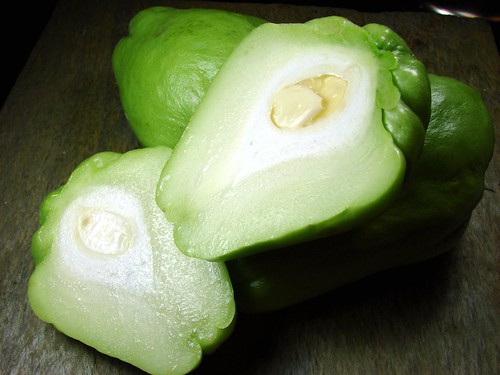
For the chayote:
4 chayote squash, halved
4 rosemary sprigs
Sea salt & black pepper
The recipe suggested peeling the chayotes and cooking in the microwave with a bit of olive oil. I don’t like handling raw chayotes, they have a sticky sap that is a pain to remove from your hands. Instead, I placed them in a pot over a steam tray, added water to the bottom, sprinkled salt & pepper over them and tucked the rosemary sprigs around them. They steamed for about 10-15 minutes and I peeled them just before serving. Easy breezy.
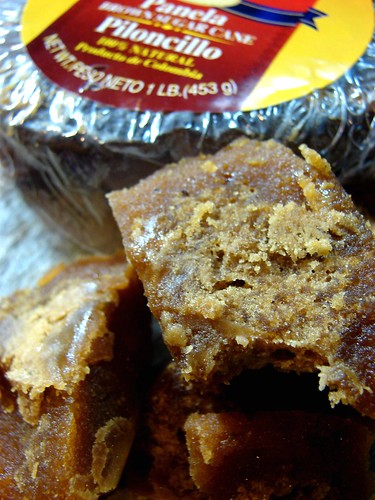
For the passion fruit caramel:
1/2 cp raspadura, crumbled
4 tbsp unsalted butter
1/2 cp passion fruit concentrate
If you cannot find raspadura, you can substitute with dark brown sugar. Melt the raspadura in a small pan and allow it to cook until it becomes caramel. Add the butter and passion fruit concentrate and cook until it thickens again, about 15 minutes. Set aside.
For the coconut foam:
1 cp unsweetened coconut milk
1 tbsp fish sauce
1 tsp fresh ginger, crushed
1/2 tsp habanero paste
1/4 tsp soy sauce
Combine all the ingredients into a small pan and bring to a boil. I didn’t end up with foam, he suggests using a hand blender, which I do not own, so I put mine into the blender. If you do own a hand blender, then keep this warm and use the blender to froth it just as you are finished plating. If you don’t, I suggest cooking down the sauce a bit, to reduce and thicken it, then you can spoon it right over the prawns.
Putting it together:
Heat a skillet and add a bit of olive oil and butter, saute the prawns, cooking for a couple of minutes on both sides (if you’re not a fan of foods with a face, feel free to remove the heads, but there is a lot of flavor there). Set aside, but keep warm.

On a plate, spread about 1 tbsp of the caramel, top with the chayote, then place a prawn atop the squash. Top witht he coconut foam or cream and be ready to ooooh and aaaah in enjoyment.
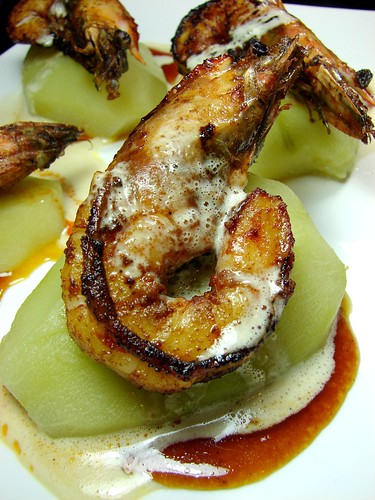
I can’t wait to make this again. Do stop by and take in Joan’s tour. For more shrimpy shots, click here and go here to see my second dish, Guacho de Mariscos y Hongos.
Cookingly yours,
Anamaris
The first time I came across Joan’s blog, Foodalogue, was because of her Culinary Tour events. She chooses a country and invites her readers on a  virtual tour of that country and its cuisine. Joan’s rules for her tour are very relaxed; one can make a traditional dish in a traditional way, OR modernize a traditional dish, OR utilize the ingredients and/or techniques of the country in your own way. The world tour will end this year visiting 7 new countries and Panama will be kicking things off.
virtual tour of that country and its cuisine. Joan’s rules for her tour are very relaxed; one can make a traditional dish in a traditional way, OR modernize a traditional dish, OR utilize the ingredients and/or techniques of the country in your own way. The world tour will end this year visiting 7 new countries and Panama will be kicking things off.
As a 100% Panameña (that’s Panamanian for non-Spanish speakers), I am required to participate and represent. Really, it’s in the constitution or something. When most people think of Panama, they think of the Panama Canal and Noriega, so before we dive into the grub, let me share some so facts regarding my homeland.
- Our borders are the Caribbean Sea, the Pacific Ocean, Colombia and Costa Rica.
- According to the 2010 country rankings by the World Economic Council of Global Competitiveness, Panama ranks 53 out of 139 countries and is expected to end up in the top 50 this year.
- As of 2010 it is the second most competitive economy in Latin America.
- Panama has the largest rainforest in the Western Hemisphere outside the Amazon.
- Basketball is big there and a number of well-known NBA players hail from the little country, including Rolando Blackman (four-time NBA All-Star) and Kevin Daley of the Harlem Globetrotters.
- Another big game, baseball. Rod Carew and Mariano Rivera both hit balls in Panama before hitting the big time.

- Panama’s cuisine is influenced by its diverse population of Hispanic, native Indian, European, African and even Chinese migrations.
- Unlike many of the neighboring countries, Panamanian food is not particularly spicy (heat).
- Yellow corn is often used for many of our dishes and fish, seafood and shellfish dishes are Panamanian specialties. For more detailed food info, check this link.

Anydoo, this past year I’ve shared many recipes and told you about foods from Panama and you can be assured that there are plenty more to come starting with 2 dishes I submitted for Joan’s tour. The first is a modern rendition using local ingredients, which could work as a beautiful appetizer, though The Hubbz and I scarfed it down as our entrée the other night. The second came as a result of one of our ‘What’s in the Bag‘ evenings. The Hubbz went to the store and brought everything but the butcher’s block, which I then had to incorporate into a meal. It is a pretty traditional dish, with a very tiny itsy bitsy twist. Ready? Here we go.
For an appetizer: Langostinos en Caramelo de Maracuyá con Aire de Coco (Prawns in Passion Fruit Caramel and Coconut Foam).

This was incredible with an exciting and complex flavor profile. I followed a recipe from Jorge Jurado’s latest cookbook ‘Sabores de Panamá‘ (Flavors of Panama). Jurado is a renown chef in Panama, who is at the forefront of a movement to elevate Panamanian dishes to haute cuisine.
In this recipe, Jurado makes use of popular local flavors: shrimp, passion fruit, chayote squash, coconut and sugar cane and hypes them up with fish sauce and smoked paprika. The final dish is assembled a layer at a time and topped with coconut foam–which I wasn’t able to accomplish, but still ended up with an insanely delicious sauce that tasted of the sea and tropical fruits. That sauce alone would make a dish unforgettable.
This dish wasn’t complicated to put together, but it does have a lot of steps. Because I usually offer step-by-step photo instructions for my dishes, I’ll limit this post to a review and description then direct you here for the how-to.
As an entrée, I offer you a semi-traditional Guacho de Mariscos y Hongos

Guacho (pronounced WAH-cho) is a sort of risotto that is topped with a flavorful sofrito. The primary, always present, ingredients in any guacho are rice and the sofrito that crowns it. Secondary and tertiary ingredients would include an assortment of any of these: various beans, pork, chicken, cured pig’s tails, seafood, and roots such as yuca and otoe.
Panamanian sofrito is generally made with onions, bell peppers, tomatoes, garlic and a few other aromatics, but this time, I added a puree made from dried chile ancho and guajillos. Also, mushrooms are not traditionally added to this dish.
For the guacho, I made a seafood broth with the shrimp skins and used it as cooking liquid for the rice which cooks until swollen plump. The seafood is added just at the end to prevent overcooking. Let me tell you, this is seafood heaven. The rice is laden with seafood and bacon flavors and is complimented by the sweetness of the shrimp and scallops. To add some textural interest, I pan-fried a few of the shrimp & scallops to top each serving. You can check out this post for the step by step recipe.
There you have it! Panamá en tu plato (Panama on your plate). Next stop… ALASKA!
Cookingly yours,
Anamaris
In my head I’m actually saying ‘pictcha time’, it sounds funny in my head, it probably makes no sense to you. And you’re probably wondering why I’m rambling in a nonsensical manner and why don’t I just get to it. So I will. Except, you know the rules, you have to go over there. You know where. To the other page where the pictured things happen.
You can see my shot here, but you should totally check out the work of the rest of the group here.
This a weekly challenge, lots of pretty pictures.
Anamaris









































